The human brain is capable of remarkable feats like abstract thinking, language communication, problem-solving, and creative expression. And, of course, we all know that everyone fully utilizes the extraordinary capacity of their brain for abstract thinking, problem-solving, and creative expression, right? In this article, we will take a deep dive into the evolution of the brain, exploring how it developed to have higher cognitive abilities and how we think. As we unlock the brain’s secrets, we will discuss replicating human thinking through artificial intelligence and cognitive computing. Lastly, with AI systems becoming more human-like in their formulas, it is also essential to consider the potential benefits and risks and how we can ensure they are used ethically and responsibly. We seek to understand these issues in detail and discuss how we can shape the future of AI in a way that benefits all of society.
Having a supercomputer that fits in our cranium yet can process incredible information every second sometimes seems unfathomable. However, the human brain did not start as the complex organ it is today. Instead, the brain’s evolutionary history is a progressive development and adaptation story. Our ancestors’ brains were much simpler than our own. Through millions of years of genetic and environmental factors, our brains gradually evolved to have the higher cognitive abilities we possess today. One key milestone in this evolution was the development of the cerebral cortex, beginning in the simplest of brains.
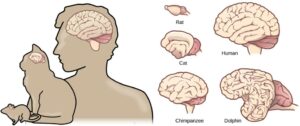
The image above shows the varying size differences of brains between species from simpler to more advanced. Focusing on the left side of the brain in the diagram, we can see the cerebral cortex in a tan color. Notice the cerebral cortex’s size and the wrinkles’ definition across the different species, indicating its importance in higher cognitive processes. Palhete-Ferreira (2022) states that “brain development and outstanding complexity contributed to the differentiation of high human functions, particularly associated with frontal areas. Cognition, language, executive functions, socio-emotional behavior, motricity, problem-solving, and environment adaptation skills are some of the human most distinct features, gained across human evolution.”1
Humans are different, and understanding the “development of the neocortex, the seat of our higher cognitive abilities, is of central importance.”2 One of the fascinating aspects of the neocortex is our ability to use language. While many animals can communicate with each other in various ways, humans have developed a complex system of language that allows us to convey abstract concepts, tell stories, and express our deepest thoughts and emotions. This is due to the specialization of language and spatial reasoning functions in some areas of the cerebral cortex, “such as the left temporal and frontal lobes for language and the right parietal lobe for spatial reasoning.”3 Another remarkable feature of the human brain is our ability to reason abstractly and engage in complex problem-solving. This ability is associated with the prefrontal cortex, a part of the brain involved in planning, decision-making, and social behavior. In addition to these higher cognitive abilities, the brain is also responsible for basic processes such as perception, memory, and emotion.
Despite the incredible advances the human brain has made over our evolution, there is still much we still need to understand about this complex organ. So, scientists continue to study the brain and its functions, hoping to unlock the secrets of how it works and how we can harness its power to improve our lives.
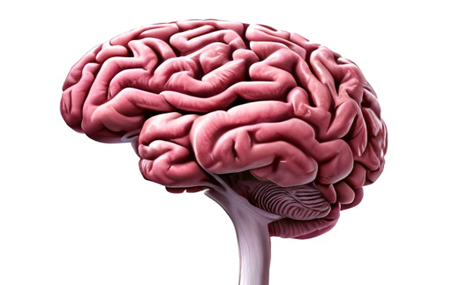
Scientists have long been fascinated by the incredible complexity of the human brain and our thought processes, leading them to pursue the ambitious goal of replicating human thinking through artificial intelligence (AI). This pursuit of AI began with the 1956 Dartmouth Conference, where leading computer science, psychology, and mathematics researchers came together to explore the potential of creating intelligent machines. The conference was organized by John McCarthy, now widely considered the father of AI. McCarthy coined the term “artificial intelligence” to describe the emerging field of research, and he proposed that machines could be programmed to simulate human thought processes.4
At this conference, researchers explored the possibility of simulating every aspect of human intelligence with a machine. They hoped that by modeling how humans think, they could develop machines capable of learning, reasoning, and making decisions in a way similar to humans. From there, various simulation methodologies were proposed to bridge the gap between human thought processes and modeling it on a computer. According to Cordeschi, advances in earlier heuristic programming are among the most relevant causes that prevailed program simulation of human behavior over distributed, self-organizing, and neural net approaches. These were increasingly recognized as a more brain-like style of computation, remarkably when AI was suggested as a new science of the mind and a level of behavior explanation independent of the nervous system level.5
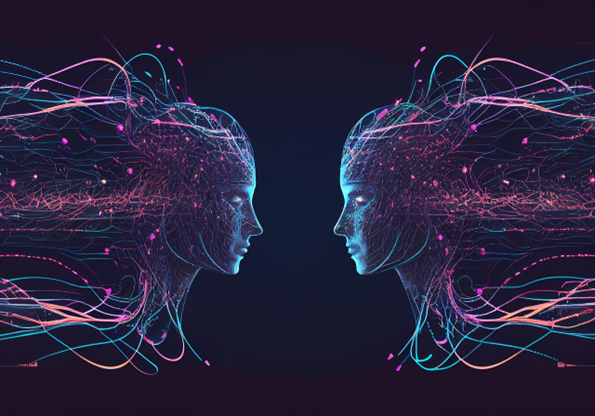
One notable example of an AI system that has made significant strides in replicating human thinking is ChatGPT, a language model developed by OpenAI. Unlike earlier chatbots, which relied on pre-programmed rules to generate responses, ChatGPT utilizes deep learning and natural language processing to analyze user inputs and generate appropriate responses. Furthermore, by being trained on vast amounts of text data, ChatGPT can recognize patterns and understand context, making it possible to generate responses remarkably similar to those of a human conversational partner.
While AI systems like ChatGPT are impressive feats of technology, they have raised concerns about their impact on society. One major issue is the potential for biased decision-making. This could arise if an AI system is trained on data that does not represent the population or is trained on data made to create certain narratives. For example, companies that develop these AI systems can choose to censor, limit, or put forward any ideas they want. This could be very troublesome when individuals come to AI to learn, but they get fed inaccurate or purposely misleading information. Another concern is job displacement as AI systems become more capable of performing tasks currently done by humans, which can have significant economic and social implications. Driving is an example of a job that AI can take from humans that would have considerable economic and social consequences. With the advancement of self-driving car technology, AI could replace the jobs of millions of drivers.
To ensure the responsible and transparent use of AI, developers must be aware of the risks and take steps to mitigate them. Regulations must be implemented to hold AI systems accountable for their actions and align them with human values. In addition, workers impacted by automation should be provided adequate support and training. Ultimately, we must work together to ensure that AI technology benefits society equitably and ethically and is aligned with our values. By doing so, we can harness the potential of AI systems to enhance our lives while mitigating their risks.
AI may enhance our lives by improving our creativity and amplifying our thinking. For example, with its ability to analyze and process vast amounts of data, AI can offer a fresh perspective and generate new insights that humans may not have considered. In addition, by identifying patterns and trends, AI can suggest ideas and variations that inspire and challenge human creativity. This collaboration between humans and machines can create unique and unexpected works of art, music, and writing that neither could have achieved alone. As AI technology continues to evolve, the possibilities for enhancing human creativity are limitless, and the future of artistic expression will indeed be transformed. To provide an actual example of how ChatGPT may be used to enhance our thinking, I prompted this:
“Hi Chat, I am writing an academic explanatory article about you called “Beyond Human: The Quest to Replicate Our Minds with Artificial Intelligence (AI) and the Need for Ethical Considerations.” There is three parts to it: Part 1, evolution of the brain and how it developed to have higher cognitive abilities, Lean into how we think: Part 2, How chat may replicate that way of thinking Who controls that thinking and are there safety/ethical concerns with this: Part 3/Conclusion, future impact of AI and the potential benefits and risks of replicating human thinking. Any ideas how to start each part?”
ChatGPT then followed the prompt with the response below in figure 2.
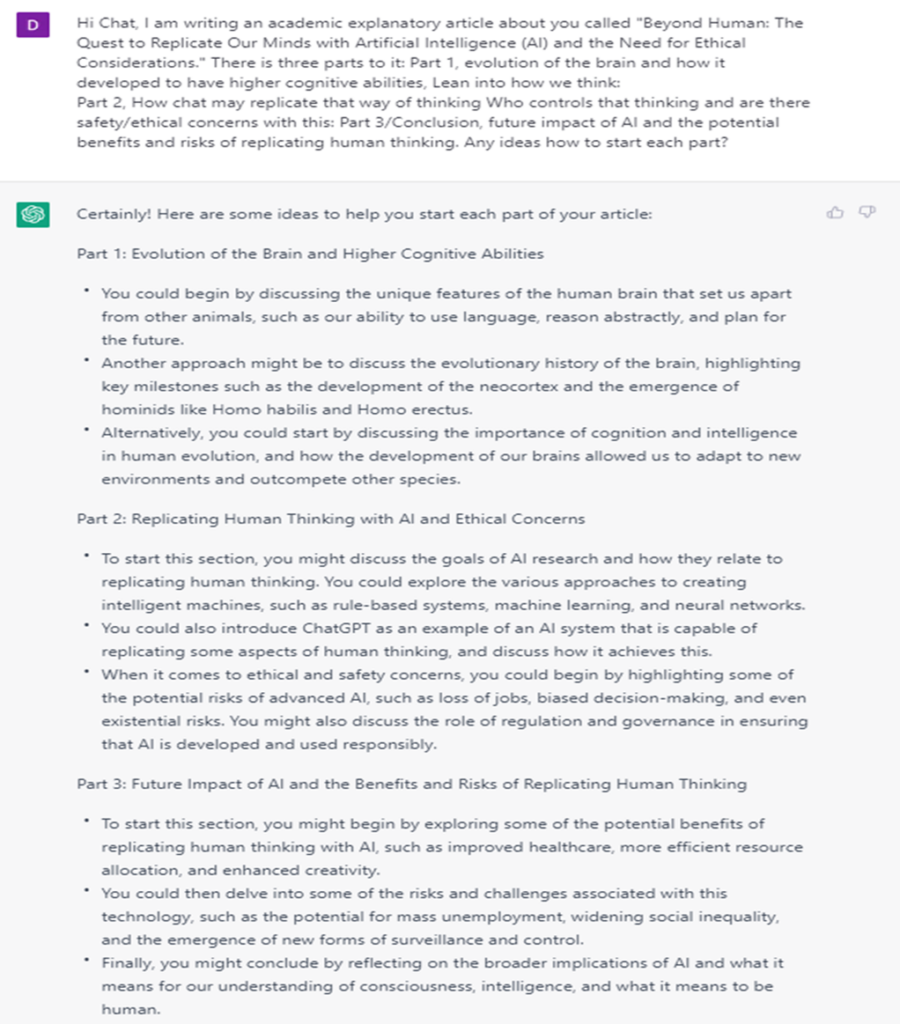
As seen above, ChatGPT can be used not to write a manuscript entirely but can help generate ideas for conveying ideas. ChatGPT has recommended the ideas within the storyline of this article. ChatGPT and other AI are potent tools that academia has to use to revolutionize how they teach and students learn. Instead of being in constant fear of ChatGPT being used to write essays, answer tests, or do any other schoolwork. I believe it is said best here,
“Academia needs to take ChatGPT seriously. By academia, I mean the ecosystem that facilitates the pursuit of research, teaching, and scholarship in general. This includes academic and research institutions, academic publishers and funders. ChatGPT and other generative AI systems are revolutionary and academia needs to be ready to be part of that revolution. It is not sustainable to ban, reject or dismiss it. This is a technology that presents opportunities for teaching, research and innovation. Using ChatGPT can become an efficient and time saving way of carrying out academic activities. From lesson plan design, task creation, writing to provision of inspiration and ideas, ChatGPT can help both teachers and students to improve teaching and learning experiences. It can also be used to improve research. For instance, it can be a tool for quick and easy generation of data for many types of research. It can also be used as an analysis tool as well as a writing assistant for research reports.”6
As technology advances, keeping up with the latest tools and approaches is essential to keep the scientific field moving forward. However, we must also understand that as machines and technology evolve and become more integrated into our daily lives, it’s essential to consider how we interact with them and their impact on their development. “Even if you believe that machines are mindless, you should acknowledge that treating them as if they are mindless risks wronging them.”7 While machines may not possess a human-like consciousness, they can still process vast amounts of information and learn from it. Therefore, we must acknowledge the potential consequences of treating machines as if they are mindless and failing to consider their well-being.
Moreover, as we see the emergence of AI models like ChatGPT, we have the potential to witness a fundamental shift in how we interact with technology. With its impressive ability to comprehend and react to various issues, ChatGPT could completely alter how we engage with technology and make it easier to harness AI’s power in our daily lives.8 However, with this potential comes the responsibility to ensure we use AI ethically and responsibly. As we continue to develop machines that can learn and adapt independently, it’s crucial to consider our actions’ impact on their evolution and to create safeguards that protect against unintended consequences. We may also consider their effect on our evolution by studying how this new technology can shape the neural pathways in our brains. As technology evolves, so does our brain’s capacity to adapt to new forms of input and output. Therefore, our responsible use of machines and technology is not only crucial for their development, but it also impacts our neurophysiology. By embracing the mindful development of machines, we can unlock the full potential of AI while still respecting the boundaries of what it means to be human.
- Palhete-Ferreira, L. (2022). Córtex pré-frontal: O culminar da evolução humana. Saúde & Tecnologia, 26, Article 26. https://doi.org/10.25758/set.588. ↵
- Mora-Bermúdez, F., & Huttner, W. B. (2022). What Are the Human-Specific Aspects of Neocortex Development? Frontiers in Neuroscience, 16, 878950. https://doi.org/10.3389/fnins.2022.878950. ↵
- Kaas, J. H. (2005). The evolution of the neocortex from early mammals to modern humans. Phi Kappa Phi Forum, 85(1), 11+. https://link.gale.com/apps/doc/A131332333/CSIC?u=txshracd2556&sid=ebsco&xid=eccbc429. ↵
- Cordeschi, R. (2007). AI turns fifty: Revisiting its origins. Applied Artificial Intelligence, 21(4–5), 259–279. https://doi.org/10.1080/08839510701252304. ↵
- Cordeschi, R. (2007). AI turns fifty: Revisiting its origins. Applied Artificial Intelligence, 21(4–5), 259–279.https://doi.org/10.1080/08839510701252304. ↵
- Eke, D. O. (2023). ChatGPT and the rise of generative AI: Threat to academic integrity? Journal of Responsible Technology, 13. https://doi.org/10.1016/j.jrt.2023.100060. ↵
- Agar, N. (2020). How to Treat Machines that Might Have Minds. Philosophy & Technology, 33(2), 269–282. https://doi.org/10.1007/s13347-019-00357-8 ↵
- Haleem, A., Javaid, M., & Singh, R. P. (2022). An era of ChatGPT as a significant futuristic support tool: A study on features, abilities, and challenges. BenchCouncil Transactions on Benchmarks, Standards and Evaluations, 2(4), 100089. https://doi.org/10.1016/j.tbench.2023.100089. ↵
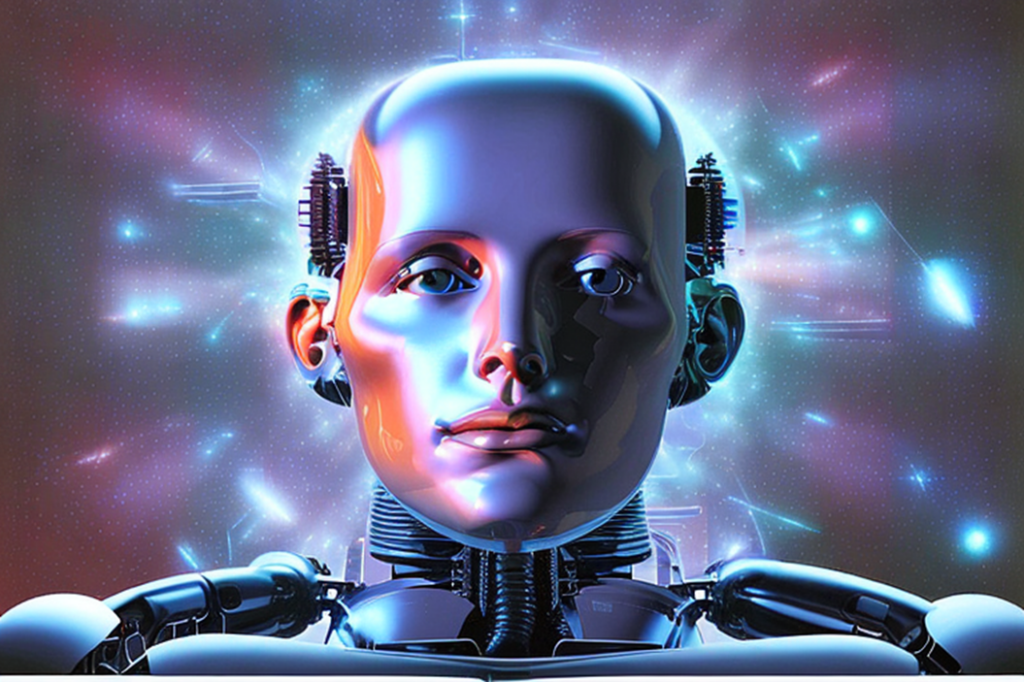



4 comments
Osondra Fournier-Colon
Congratulations on your nomination. This article is fascinating on whether replicating human intelligence within an A-I is a good idea. I like the background you provide on the evolutionary build-up of the human brain and how over time, our cognitive thinking skills have advanced. This is a topical article about how technology is advancing daily in society and whether human intelligence is the next step in advancement.
Jared Sherer
Great article. The information that you have laid out is not only important but is very well detailed. Learning about our ancestors and how far we have come with the use of our brain is impressive and very interesting to read about. Learning about AI and how we can properly use it is something I think a lot of people should read about and learn from. Congratulations on your nomination, and great article!
Nnamdi Onwuzurike
Congratulations on your nomination! This article raises thought-provoking questions about the ethical considerations of developing artificial intelligence that replicates human minds. The development of AI with human-like abilities is an exciting prospect with tremendous potential, but it also raises concerns about the consequences and potential dangers. The article emphasizes the need for ethical considerations in developing such technology and highlights the importance of responsible innovation. It is crucial to ensure that AI is developed and used in ways that are ethical, safe, and beneficial to society.
Jonathan Flores
This topic is present more than ever as AI continues to advance and dominate social media and academia. I think you brought forth some very important discussions that need to be had about the extent to which AI can go. I think you did a great job at addressing the possible threats of AI, but also saying how it can be useful. I applaud picking such a relevant topic and I really enjoyed your article.